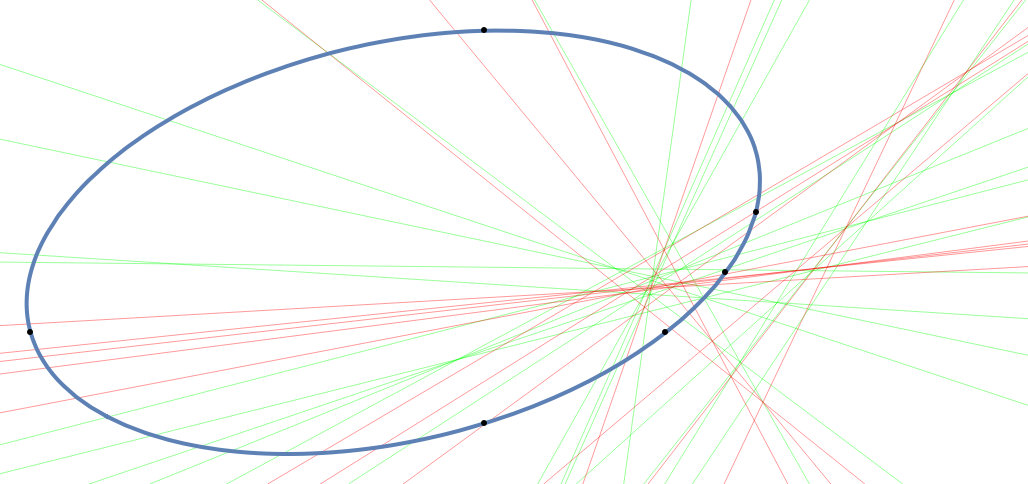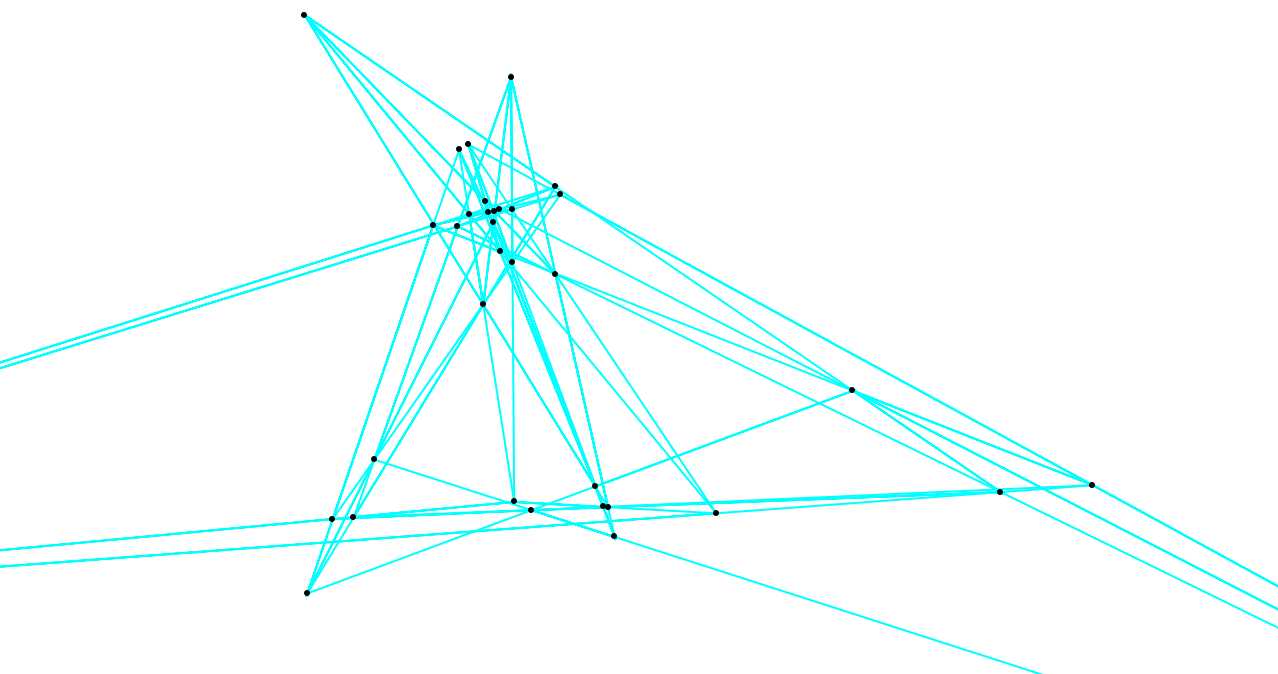Details
ResourceFunction["HexagrammumMysticum"] returns an
Association with six parts, consisting of three sets of lines (Pascal, Cayley, Pluecker) and three sets of points (Kirkman, Steiner, Salmon):
| "Pascal" | Pascal lines |
| "Cayley" | Cayley lines |
| "Pluecker" | Plücker lines |
| "Kirkman" | Kirkman points |
| "Steiner" | Steiner points |
| "Salmon" | Salmon points |
From six points on a conic section (circle, ellipse, parabola or hyperbola), label them B L A I S E and connect them to form a hexagon. There are 15 ways to choose two points, leading to 15 lines that intersect at 45 points.
If opposing sides (BL-IS, LA-SE, AI-EB) are extended, the three intersections are collinear, forming what is called a Pascal line. Six points give 60 possible hexagons, with a Pascal line for each hexagon. L(BLAISE) is one of these 60 Pascal lines.
Consider the vertices of a hexagon as a cyclic permutation and square that as a permutation. For example, BLAISE, BLSEAI and BISLAE have permutations (123456), (125634) and (145236), all with the same permutation square BAS.LIE or (135)(246). There are 20 possible results in sets of three, always giving a pair of 3-cycles. In any of these sets, the three corresponding Kirkman points are collinear, forming what is called a Cayley line. L(BAS.LIE) is one of these 20 Cayley lines.
Consider one of the 15 triplets of 2-cycles, such as BL.AI.SE or (12)(34)(56). Find the four Steiner points that commute with the given cycle under permutation products. In this case, (12)(34)(56)×(135)(246)=(135)(246)×(12)(34)(56), and similarly for (136)(245), (145)(236) and (146)(235). These four Steiner points are collinear, forming what is called the Plücker line. L(BL.AI.SE) is one of these 15 Plücker lines.
For a given hexagon on six points, consider the three other hexagons that share no edges with the first. For the hexagon BLAISE, the three others are BASLEI, BAEILS and BILEAS. These three hexagons define three Pascal lines that concur on a Kirkman point. Each of the 60 hexagons defines a Kirkman point. P(BLAISE) is one of these 60 Kirkman points.
Just as in Cayley's case, consider a hexagon as a cyclic permutation and square that as a permutation. There are 20 possible results in sets of three. In any of these sets, the three corresponding Pascal lines concur on a Steiner point. P(BAS.LIE) is one of these 20 Steiner points.
As shown in Plücker, consider one of the 15 triplets of 2-cycles. The four corresponding Cayley lines concur on a Salmon point. P(BL.AI.SE) is one of these 15 Salmon points.
There are 60 Pascal lines and 60 Kirkman points, 20 Cayley lines and 20 Steiner points, and 15 Plücker lines and 15 Salmon points, for a total of 95 lines and 95 points that form what is called the Hexagrammum Mysticum.
Conway extended Hexagrammum Mysticum even more, but that's an exercise for the user.
Sets of six small integer points on a conic which avoid parallelization problems are difficult to find. A short list of examples is provided in the Definition section.
![pts = {{-12, -3}, {3, -6}, {3, 7}, {9, -3}, {11, -1}, {12, 1}};
hm = ResourceFunction["HexagrammumMysticum"][pts];
Style[Short /@ hm, 8]](https://www.wolframcloud.com/obj/resourcesystem/images/fd2/fd25d118-b5ff-48e0-a778-78c54a73862c/14d1b42faae2dba9.png)



![Graphics[{AbsoluteThickness[.2],
Green, Hyperplane[Take[#, 2], Last[#]] & /@ (Values@Lookup[hm, "Cayley"]),
Red, Hyperplane[Take[#, 2], Last[#]] & /@ (Values@
Lookup[hm, "Pluecker"]), ContourPlot[-135 + \[FormalX]^2 - \[FormalX] \[FormalY] + 3 \[FormalY]^2 == 0, {\[FormalX], -13, 21}, {\[FormalY], -8, 8}][[1]], Black, Point[pts]}, PlotRange -> {{-13, 21}, {-8, 8}}]](https://www.wolframcloud.com/obj/resourcesystem/images/fd2/fd25d118-b5ff-48e0-a778-78c54a73862c/38e99a46591d3e16.png)

![Graphics[{AbsoluteThickness[1],
Cyan, InfiniteLine[#] & /@ Partition[points, 2, 1, 1],
Red, Hyperplane[Take[pascal1, 2], Last[pascal1]],
Black, ResourceFunction["NumberedPointPlot"][points][[1]]},
PlotRange -> {{-16, 20}, {-20, 15}}]](https://www.wolframcloud.com/obj/resourcesystem/images/fd2/fd25d118-b5ff-48e0-a778-78c54a73862c/5c3a2c58b5348558.png)

![Graphics[{AbsoluteThickness[1],
Table[{{Purple, Yellow, Cyan}[[k]], InfiniteLine[#] & /@ (Partition[points[[kirkhex[[k]]]], 2, 1, 1])}, {k, 1, 3}],
Red, Hyperplane[Take[#, 2], Last[#]] & /@ lines,
Black, ResourceFunction["NumberedPointPlot"][points][[1]],
Blue, Circle[kp, 1/4]},
PlotRange -> {{-16, 20}, {-20, 15}}]](https://www.wolframcloud.com/obj/resourcesystem/images/fd2/fd25d118-b5ff-48e0-a778-78c54a73862c/529dbbbcee800d45.png)

![ran = RandomReal[{-4, 4}, {5, 2}];
conic = ResourceFunction["FivePointConic"][ran];
randomconic6 = Append[ran, {0, Sort[\[FormalY] /. (Quiet@Solve[{\[FormalX] == 0, conic == 0}])][[
1]]}]](https://www.wolframcloud.com/obj/resourcesystem/images/fd2/fd25d118-b5ff-48e0-a778-78c54a73862c/4c498dfd4a648315.png)

![hm = ResourceFunction[
"HexagrammumMysticum"][{{-2, 3}, {0, 3}, {2, 4}, {-5, 6}, {-5, 18}, {8, 19}}, {"Steiner", "Salmon"}];
p35 = Join[(Values@("Steiner" /. hm)), (Values@("Salmon" /. hm))];](https://www.wolframcloud.com/obj/resourcesystem/images/fd2/fd25d118-b5ff-48e0-a778-78c54a73862c/28a343ecb6cbe701.png)

